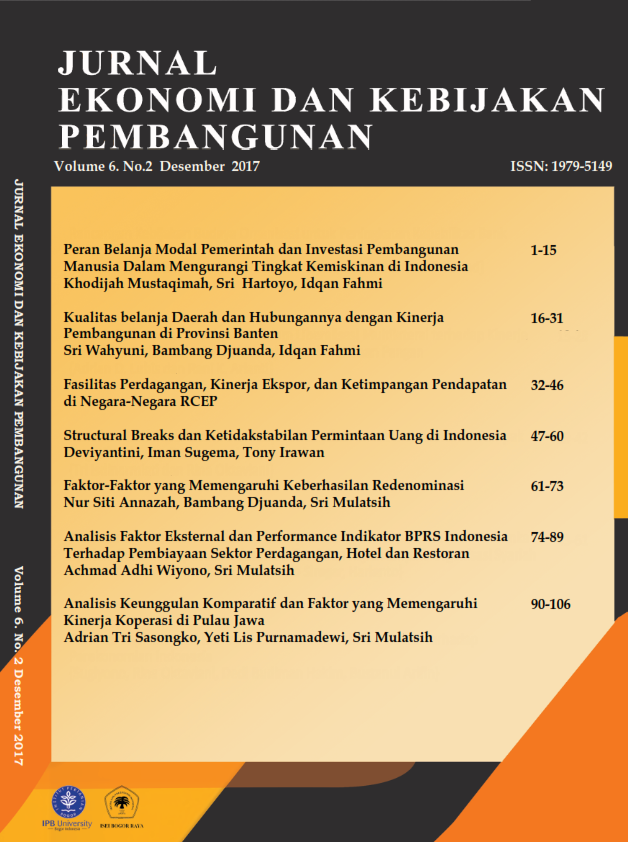STRUCTURAL BREAKS DAN KETIDAKSTABILAN PERMINTAAN UANG DI INDONESIA
Abstract
This research aims to identify the sources of instability of the money demand function (M1 and M2) due to structural changes that occur as a result of economic shocks. These shocks are technically shown by the presence of structural breaks in the data and can lead the parameters non-constancy. The instability of the money demand function was analyzed using the Gregory and Hansen test. The source of instability of the money demand was identified using time varying parameter model. This research used quarterly time series data from 1993Q1 to 2013Q4. The results show that the money demand function (M1 dan M2) is not cointegrated (unstable) and the source of the instability is exchange rate variable.
Keywords: Stability money demand, Structural breaks, Time varying parameter model
References
Arango S, Nadiri MI. 1981. Demand for Money in Open Economies. Journal of Monetary Economics 7: 69-83.
BI (Bank Indonesia). 2013. Seni Kebijakan Moneter. Gerai Info Newsletter Bank Indonesia Edisi 40, Juli 2013, Tahun 4.
Dickey DA, Fuller WA. 1979. Distribution of the Estimators for Autoregressive Time Series with a Unit Root. Journal of The American Statistical Association 74 (366): 427-431.
Dreger C, Wolters J. 2010. Investigating M3 Money Demand in the Euro Area. Journal of International Money and Finance 29 : 111-122.
Dritsakis N. 2012. Structural Breaks, Cointegration and the Demand for Money in Greece. The IUP Journal of Applied Economics XI (3): 5-21.
El-Shazly A. 2016. Structural Breaks and Monetary Dynamics: A Time Series Analysis. Economic Modelling 53: 133-143.
Enders W. 2004. Applied Econometric Time Series. Second Edition. United States of America: John Wiley & Sons, Inc.
Ericsson NR. 1998. Empirical Modelling of Money Demand. Empirical Economics 23: 295- 315.
Farhani S. 2012. Tests of Parameter Instability: Theoretical Study and Empirical Analysis on Two Types of Models (ARMA Model and Market Model). International Journal of Economics and Financial Issues 2 (3): 246-266.
Gregory A, Hansen B. 1996a . ResidualBased Tests for Cointegration in Models with Regime Shifts. Journal of Econometrics 70: 99- 126.
. 1996b . Tests for Cointegration in Models with Regime and Trend Shifts. Oxford Bulletin of Economics and Statistics 58 (3).
Karmeli E, Fatimah S. 2008. Krisis Ekonomi Indonesia. Journal of Indonesian Applied Economics 2 (2): 164-173.
Narayan PK. 2007. Is money targeting an option for Bank Indonesia?. Journal of Asian Economics 18: 726-738.
Setiawan A. 2011. Inflation Targeting Framework dan Perubahan Respon Kebijakan Moneter. Tesis. Jakarta: Universitas Indonesia.
Suwedayana IPGDG, Sumarjaya IW, Sucipawati NL. 2016. Peramalan Jumlah Kunjungan Wisatawan Australia yang Berkunjung ke Bali Menggunakan Model Time Varying Parameter (TVP). EJurnal Matematika 5 (3): 117-125.
Warjiyo P, Solikin. 2003. Kebijakan Moneter di Indonesia. Seri Kebanksentralan Nomor 6, Pusat Jurnal Ekonomi dan Kebijakan Pembangunan, hlm. 47-60 Vol 6 No 2 Pendidikan dan Studi Kebanksentralan. Bank Indonesia,
Wheale RW, Amin LH. 2010. Bursting the dot.com “Bubble”: A Case Study in Investor Behaviour. Technology Analysis & Strategic Management 15 (1): 117-136.
Zivot E, Andrews DWK. 1992. Further Evidence on the Great Crash, the Oil-Price Shock, and the UnitRoot Hyphothesis. Journal of Business and Economic Statistics 10 (3): 251-270.
Authors

This work is licensed under a Creative Commons Attribution-NonCommercial-ShareAlike 4.0 International License.
The authors who publis article(s) in Jurnal Ekonomi and Kebijakan Pembangunan have to understand and agree that the copyright of article published is owned by Jurnal ekonomi and Kebijakan pembangunan including to reproduce, distribute and sell this journal to public.





